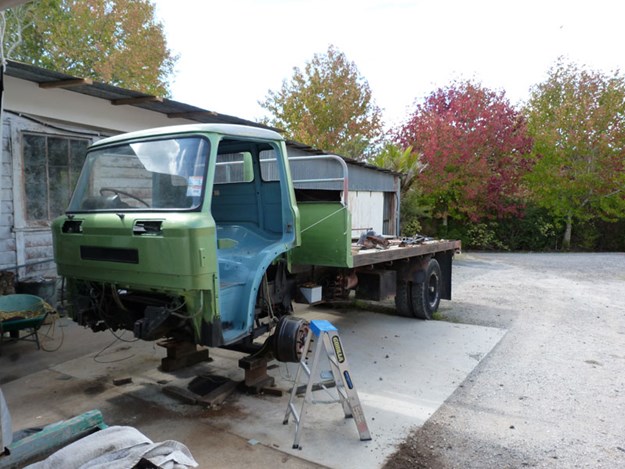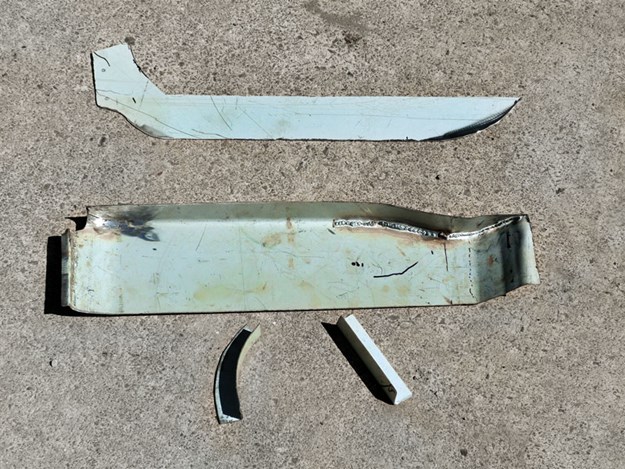Restoration: Ford D750—Part 8
The latest chapter in Deals on Wheels restorer Lyndsay Whittles project for the Ford D750
 |
|
We got the glass in just in time before the COVID-19 lockdown
|
The man who was reading the article is Lance Slater from Huntly who coincidentally owns a 1966 Ford D200, hence his particular interest these trucks. Lance says that he picked up the truck a while back and that he had to cut a tree down before he could get the vehicle out of its shed.
 |
|
Yet another D Series being saved courtesy of Lance Slater from Huntly
|
I’ve included a picture courtesy of Lance for the benefit of all the D Series enthusiasts out there and to show the ends some people will go to in order to get their hands on one.
Lance’s interest in finding out exactly how I was going to magically get myself an extra gear in my truck without doing any mechanical work to achieve the result reminded me that I’d been slack with my article writing.
As I said, Lance was reading Part 6 in DOW Issue 322 and I’d promised the readers that I’d report on the situation in the next edition, however, when I had a read of Issue 323, any explanation was conspicuous by its absence.
What had happened was, a friend of a friend who knows D Series Fords like the back of his hand took one look at the gearbox and immediately identified it as being a five-speed model, whereas I’d thought for the last two or three years that I’d bought a truck with a four-speed, two-speed diff.
I can’t blame anybody for thinking I must be as thick as pig whatsit, having owned a vehicle for two or three years and not knowing how many gears it has, but I must say in my defence that I’ve only ever driven the truck around a paddock just to keep everything working while it’s been awaiting restoration. It’s my excuse and I’m sticking to it.
While we’ve been in this state of lockdown, I’ve used the slower pace of current-day living to do a lot of those odd jobs that we all consider ourselves too busy to do. One such job was to remove the D Series’ gear lever knob and give it a clean, and sure enough, the knob has the gearshift pattern engraved on it.
If I’d taken the time to look more closely at it, I’d have realised that I always had five forward gears; 10 if you count the two-speed diff when I finally get around to finding out why it’s stuck in one range.
Come to think of it, I’m not even sure whether it’s stuck in high or low. Suffice to say that I’m going to learn quite a bit about my truck when it finally goes on the road. Still, I guess it all adds to the excitement.
Talking of the truck going back on the road, it’s looking like that’s going to take a lot longer to happen than I’d ever imagined when I started out on this particular journey. Based on my previous four restorations, I’d calculated that this one would only take around a year to complete, maybe 14 months if we ran into problems along the way.
Currently, we’re sitting at eight months on the job to-date and there’s an awful way to go yet, and while the lockdown is providing me with a few excuses for dragging the chain, I’m afraid I’m going to have to re-evaluate my timeline and extend it to say, 15 or 16 months.
I’ve said in past articles that the cab was relatively rust-free, and to a large extent, that contention is correct. For instance, when we removed the front and rear glass, the window seams were like new and didn’t need repainting.
 |
|
Rear glass in
|
Also, most of the rust on the rest of the cab was only of the surface variety. However, when it came to turning my attention to the areas on the underside of the stepwells, to my dismay, I found that they were more badly rusted than I’d first thought.
 |
|
The LH step under construction
|
When I attacked these areas with a disc grinder, bits fell off in chinks, leaving me with only the step on the driver’s side to use as a pattern for reconstruction. Thinking about it, the passenger-side step had been rebuilt at some stage in the past, and like most repairs that are made simply to keep a vehicle on the road, this job had been done to serve a purpose rather than to replicate the original design.
.jpg) |
|
The LH step under construction
|
Given that this time around we’re carrying out a restoration, every reasonable effort should be made to re-create something that bears at least some resemblance to the original creation.
I think I’ve admitted before that I’m not the brightest light in the harbour, so this part of the restoration is testing my tiny brain to its absolute limits. The original step had a pressed pan that sits on the underside; it’s multi-shaped with compound curves.
 |
|
The pan partly fabricated
|
Not having the expertise nor indeed the money to even begin thinking about making a mould for a one-off part that will never be seen by anyone other than vehicle inspectors at COF time, I’ve had to content myself with fabricating the piece as best I can using the right-hand step as a pattern.
I’ve been working to a tight deadline in order to have it finished in time to go in this article, but unfortunately, I’ve been laid-up with an eye infection (working in the bush at home in case anyone’s asking) so any pictures of the finished product will have to wait until next month’s article I’m afraid.
Aside from the main body of the truck, there are always other little bits and pieces, such as door hinges for instance, that need to be tidied when I have a few spare moments. It’s always good to have ancillary items finished off and sitting in stock, ready to go back on the truck when the larger parts need to go back on. So I guess it’s a case of sticking to the programme and to press on.
Find more trucks for sale in NZ
Keep up to date in the industry by signing up to Deals on Wheels' free newsletter or liking us on Facebook.





.jpg)


.jpg)


.jpg)

.jpg)


.jpg)
